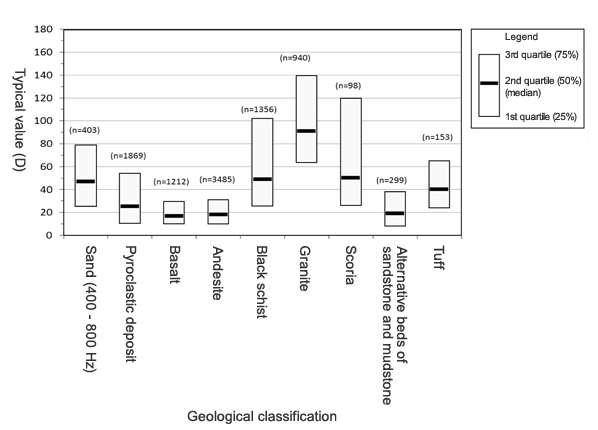Precautions concerning conditions of measurement
Types of soil ground and sound loudness
Fig. 1 shows the typical values (D) measured with the groundwater aeration sound measuring device in various places in Japan that have been organized according to the type of geology.
As for the setting values for the device, measurement was made with a filter frequency of 300 - 1,200 Hz and 5 times as the rate of amplification.
Note that with regard to sand, measurement was made in a sandy area along a seacoast, and the filter frequency was 400 - 800 Hz, with a narrower range than that for the other types of geology.
Also, n in the figure represents the number of measurement points, and measurement was made at 9,265 points in total.
The number of measurement point varies with geology, and those with a small number of measurements such as scoria are also included.

Fig. 1 Relations between the typical value (D) and geology(measured the typical value (D) at filter: 300 - 1200 Hz, with AMP5)
(Reference literature: Edited by Shin Nihon Henshu Kikaku (2014) "Techniques for Slope Collapse Preventive Measures: Mechanism, Sensing, Monitoring System and New Method of Construction Work" P. 221, NTS Inc.)
Regarding the typical value (D) that was measured with black schist (metamorphic rock), granite, scoria, and sand that are likely to be subjected to grain coarsening and to turn into gravel or sand after weathering, the value of the 2nd quartile which is the median is great, and the ranges of the 1st and 3rd quartiles that represent the dispersion of values are wide.
Whereas, with basalt, andesite that are likely to turn into clay after weathering, the value of the 2nd quartile which is small and the ranges of the 1st and 3rd quartiles that represent dispersion are also small.
Also, in pyroclastic deposits, tuff, and alternative beds of sandstone and mudstone, both sand or gravel and clay exist in a mixed manner in many cases, and the loudness and dispersion of the sound of water flowing underground are considered to be values that lie intermediate between the values of sand or gravel and clay.
Based on these, the geology of gravel and sand having coarse grains has characteristics such that the loudness of water flowing underground is great, and the geology of clay having small grains has characteristics such that the loudness becomes small.
It is thought that this is due to the fact that the size of the gap varies with the grain size.
Namely, the size of the gap becomes smaller in the order of gravel > sand > clay, and similarly the size of bubbles formed in the gap also becomes smaller in the order of gravel > sand > clay.
It can be considered that since the aeration sound given off when bubbles break has lower frequency and is unlikely to attenuate as the bubble size increases, the loudness of water flowing underground is great in the geology of gravel and sand having coarse grains, and it becomes small in the geology of clay having small grains, but this point has not been confirmed yet. Also, it is thought that, in general, elastic waves has a greater rate of attenuation in clay than in gravel or sand, and therefore the loudness becomes smaller in clay.
On the depth of exploration
It can be considered that the depth of exploration varies with the flow rate, inclination, and geology, but the results in the past have shown that exploration can be done down to a depth of around 10 m.
Influence of sound in the surrounding areas
Sounds in the surrounding areas such as those from automobiles, airplanes, helicopters, etc. may become the noise and affect the measured values. In such a case, measurement should be suspended until the source of sound that becomes the noise disappears, and measurement should be restarted after the noise has disappeared.
The built-in filter cannot eliminate noise in the surrounding areas completely (it can reduce the noise). It is especially susceptible to the influence of wind. Actually, when the low cut filter is 300 Hz or less, influence becomes greater at wind speed of 2 m/s or more, and when the low cut filter is 200 Hz at wind speed of 1 m/s or more.
It is recommended that measurement be made on days without strong wind in a quiet place.
Influence of weather conditions
During rainfall or on days with strong wind, drops of rainwater and air hissing sounds become noise and it disables accurate survey, and so measurement should be made by avoiding such days.
Timing of measurement after rainfall has ended
In the case of normal rainfall, measurement can be made on the next day, but right after a heavy rainfall such as that in a typhoon, etc., the swaying of the level meter may be great in any place and the groundwater path cannot be estimated correctly. For this reason, after a heavy rainfall, it becomes easier to estimate the groundwater path if measurement is made 2 - 3 days later.
